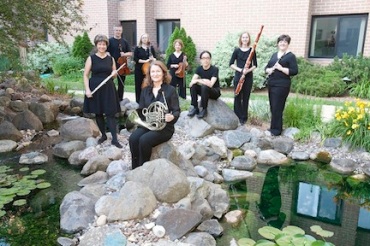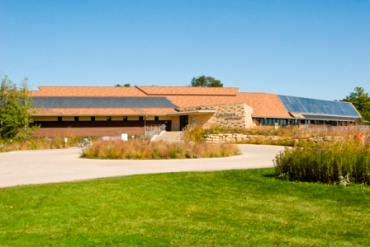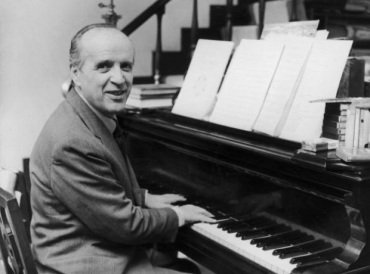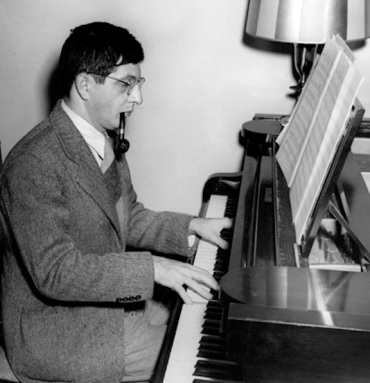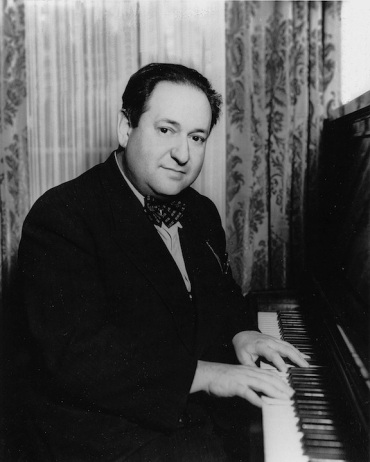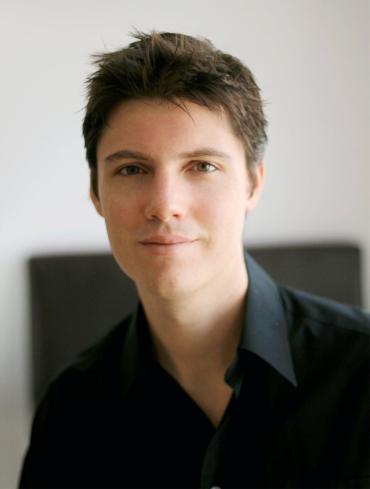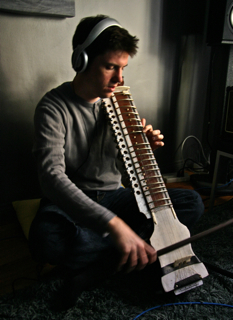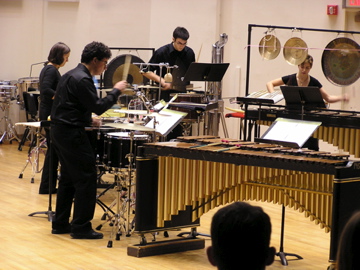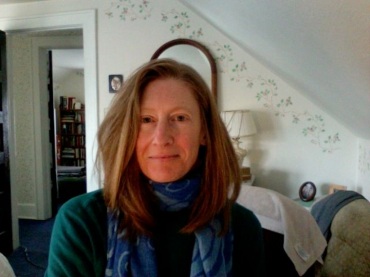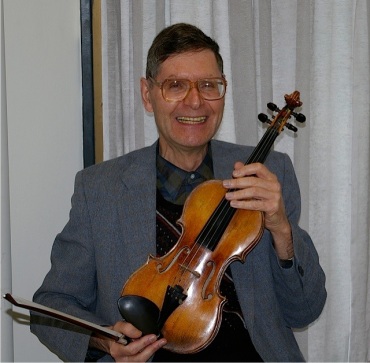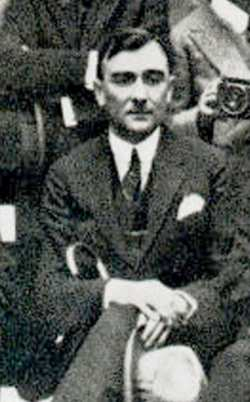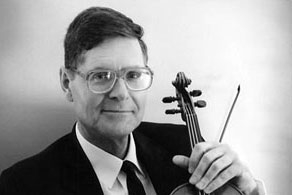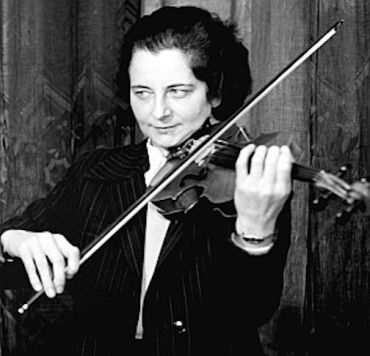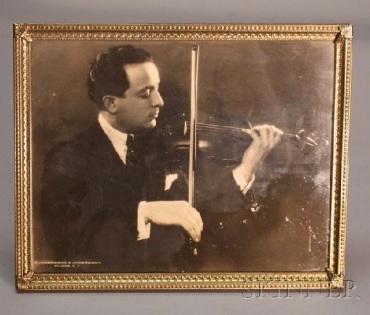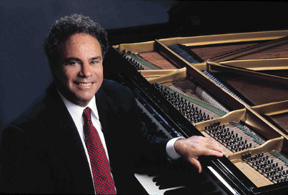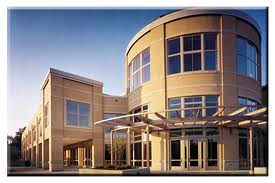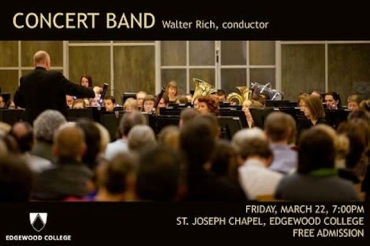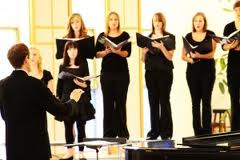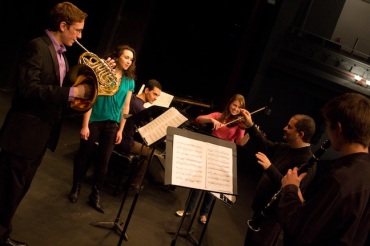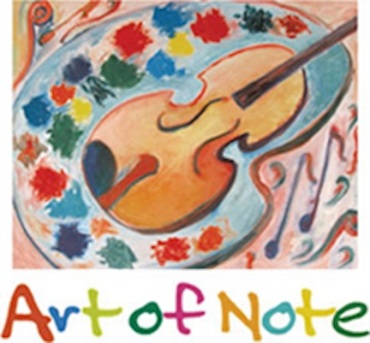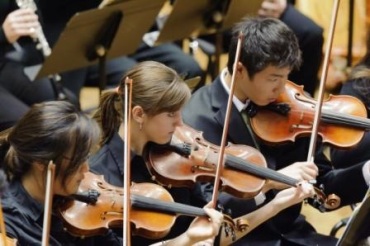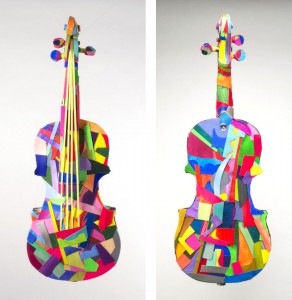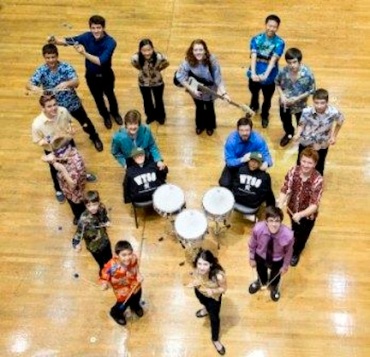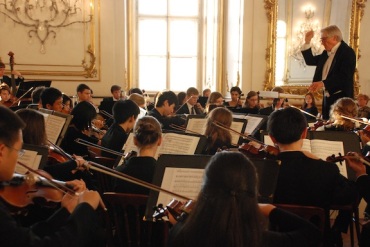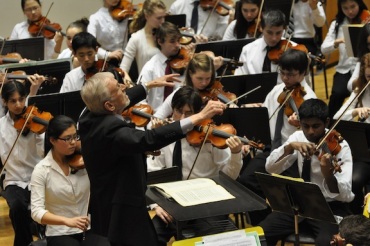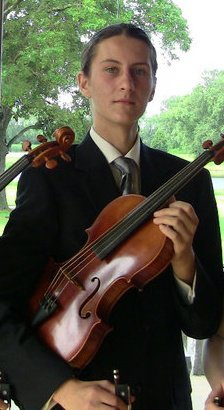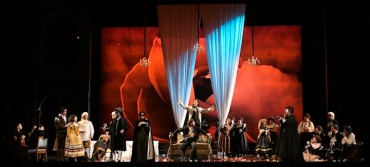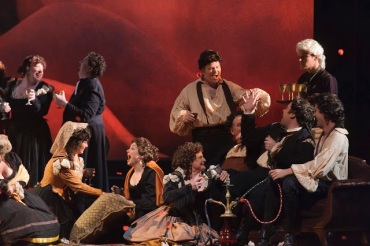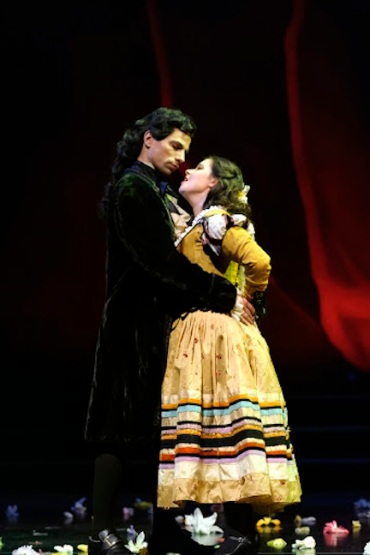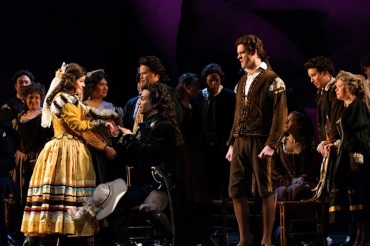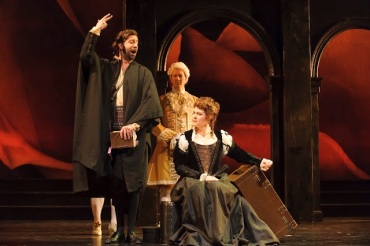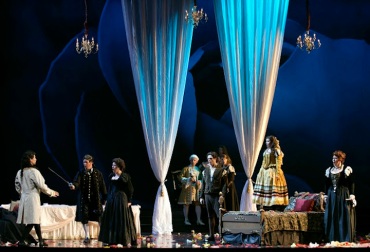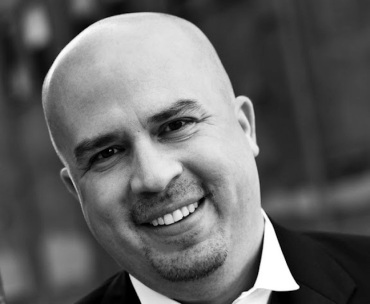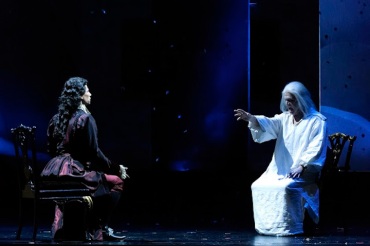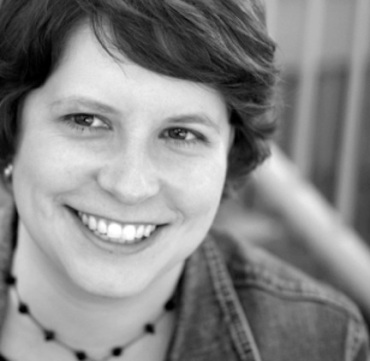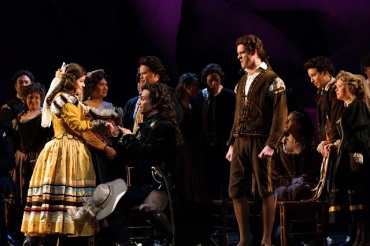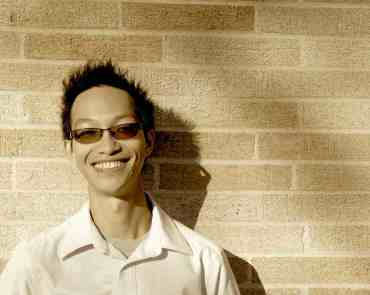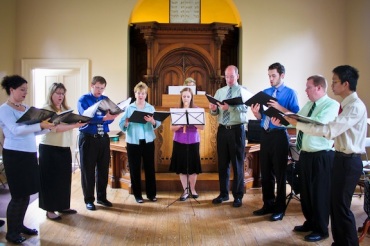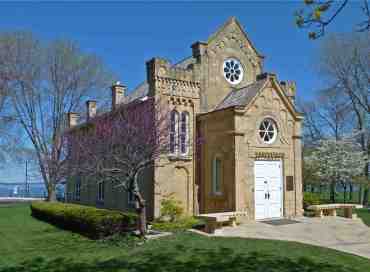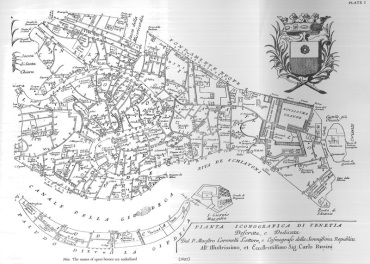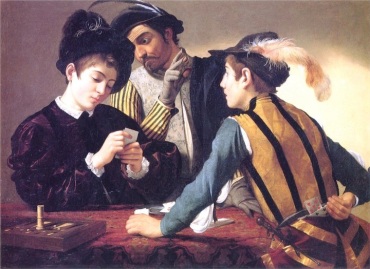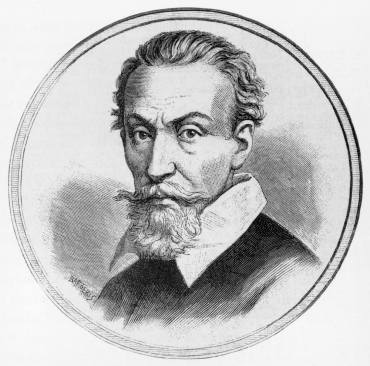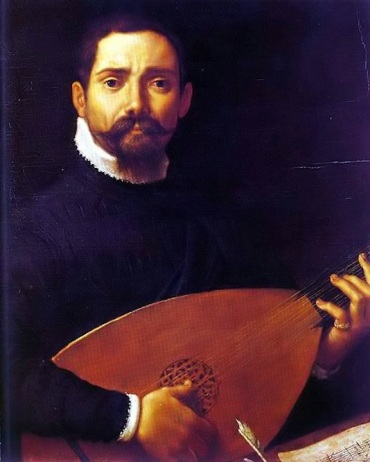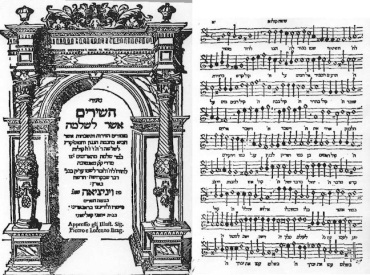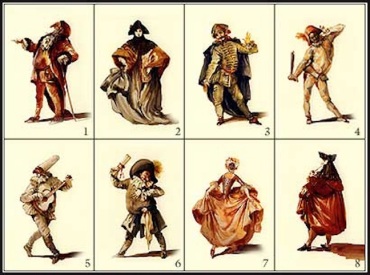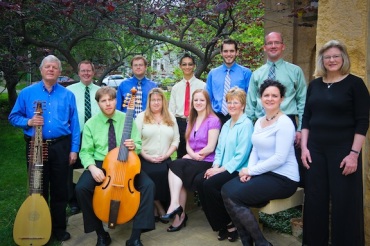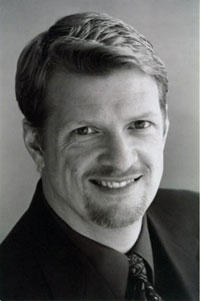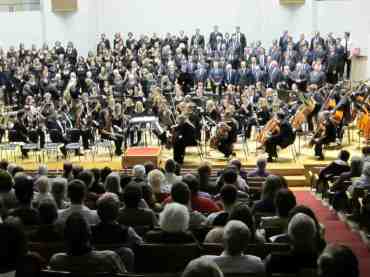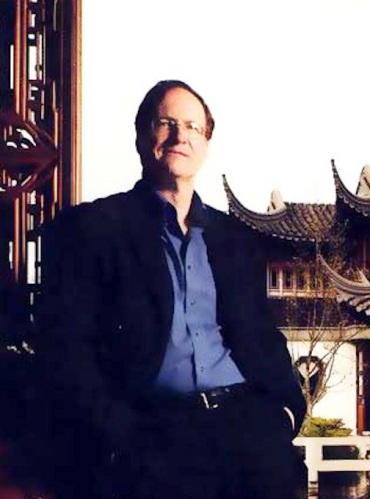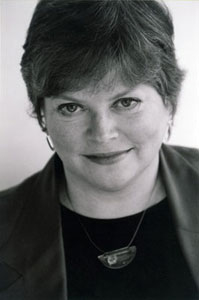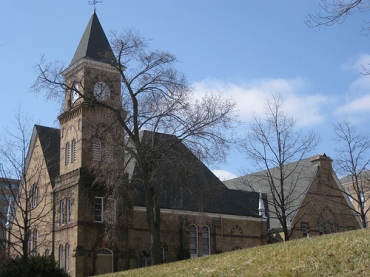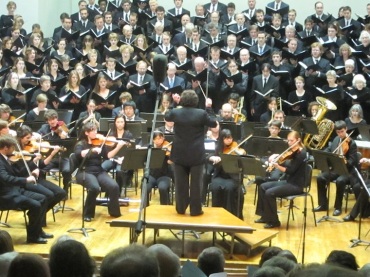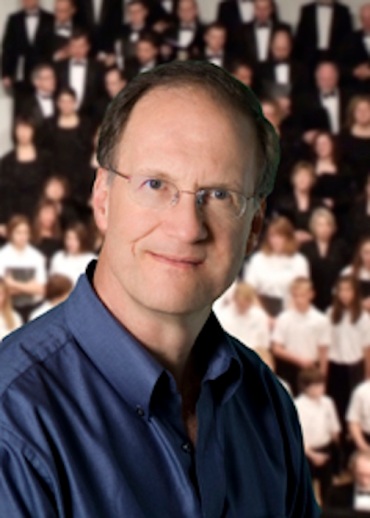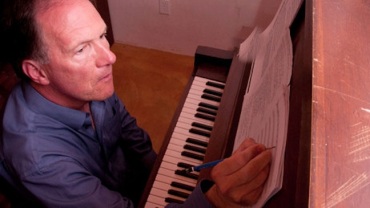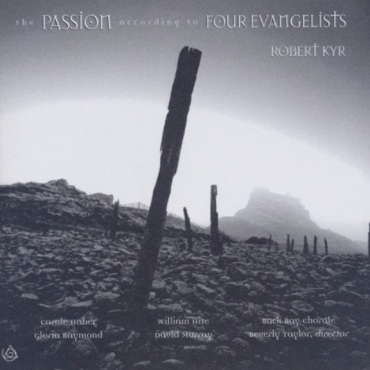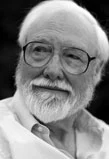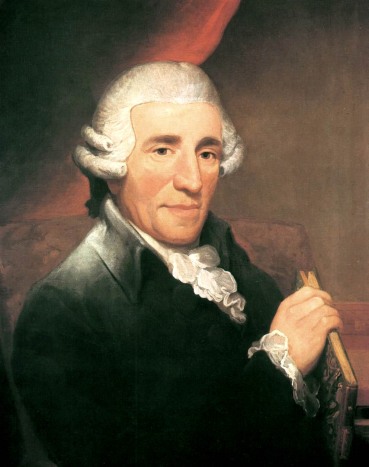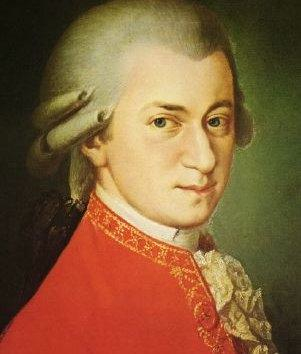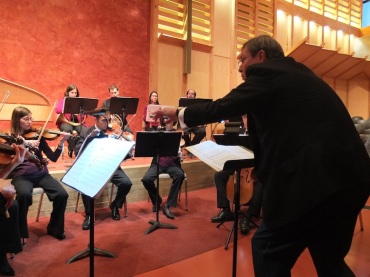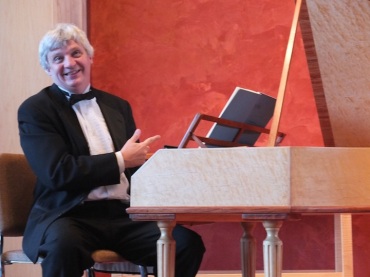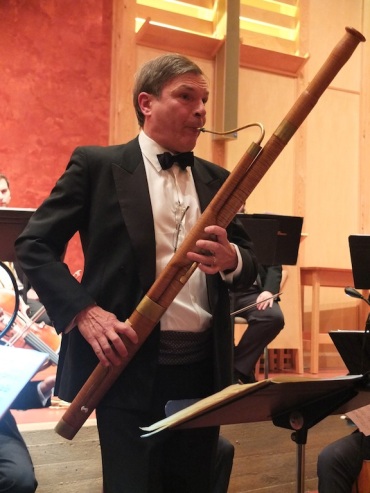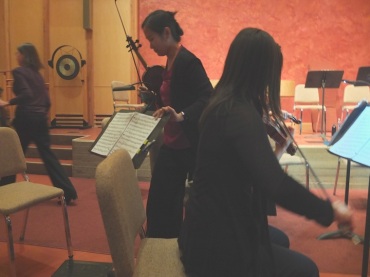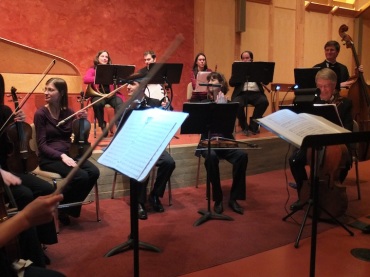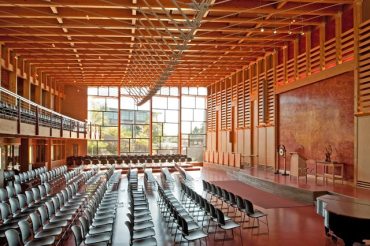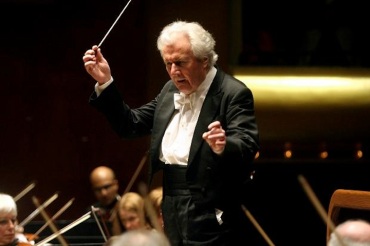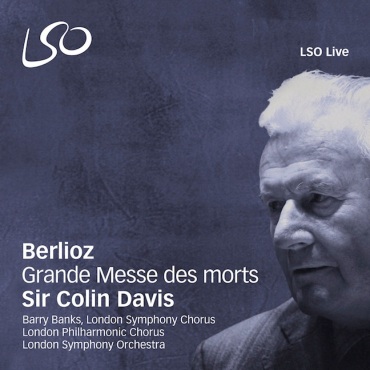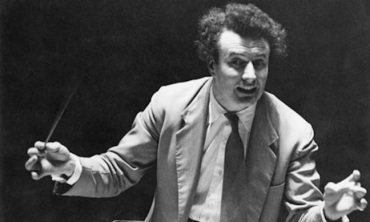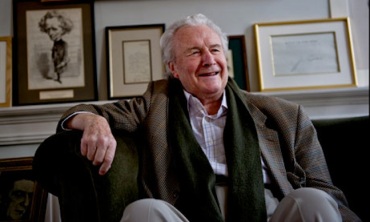The Well-Tempered Ear
Classical music: The Oakwood Chamber Players end its season this Saturday night and Sunday afternoon by performing music by movie score composers, including Nino Rota, Erich Wolfgang Korngold, Bernard Hermann and Wisconsin native Ian Honeyman.
Leave a Comment
By Jacob Stockinger
Increasingly, movie scores –- at least the best and most original of them — and their composers are being recognized as a logical and legitimate extension of or integral part of classical music, a close crossover cousin or fusion genre, if you will.
Many of the best movie scores came from classical musicians who, being Jewish, had to flee Nazi Germany. Many ended up in Hollywood, and used their musical gifts to make a living even while they privately pursued their “serious” or “art” music.
That trend of rediscovering and performing such composers and works continues locally this weekend when the Madison-based Oakwood Chamber Players (below), who are musically masterful and programatically adventuresome, will present two concerts with works by famous film composers of the 20th and 21st centuries.
The concerts are on this Saturday night, May 4, 2013, at 7 p.m. at the Oakwood Village University Woods Auditorium, 6201 Mineral Point Road, and on this Sunday afternoon, May 5, at 1:30 p.m. at the UW-Arboretum Visitor Center (below).
Tickets are available at the door: $20 for general admission, $15 for seniors and $5 for students.
Visit www.oakwoodchamberplayers.com for more information.
“The Movies” concerts will explore music from a range of backgrounds — Italian, American and Austrian — and will be tied together by their composers’ love of the cinema.
Four composers will be featured during the concerts. The composers will include:
Nino Rota (below): Known for his collaboration Federico Fellini and on the Academy Award winning score for “The Godfather II”, his Nonet for Strings and Winds (at bottom in a YouTube video with Gidon Kremer’s chamber group) is a roller-coaster ride of moods.
Bernard Herrmann (below): He composed a hauntingly beautiful Quintet for clarinet and strings that will showcase this Hollywood film composer famous for his film scores, especially for Alfred Hitchcock, in “Psycho,” “Vertigo,” “Cape Fear,” “Journey to the Center of the Earth” and “Citizen Kane.”
Erich Wolfgang Korngold (below): Setting the swashbuckling tone for “The Adventures of Robin Hood” and “The Sea Hawk,” in his substantive and delightful Piano Trio Korngold shows an incredible ability to convey mood with grand gestures.
Ian Honeyman (below): Originally from the Madison suburb of Oregon, Wisconsin, and now based in Los Angeles, the 34-year-old award-winning Honeyman has written music for dozens of feature films, short films, TV shows and was a collaborative composer and arranger on the best-selling film “Pirates of the Caribbean: The Curse of the Black Pearl.”
His suite from the feature film, “Lilly the Witch: The Dragon and the Magic Book,” represents exciting work. Honeyman’s early influences include Oakwood Chamber Players violinist Leyla Sanyer. He arranged excerpts from one of his movie scores for the Oakwood Chamber Players, which will receive its world premiere next weekend.
As Honeyman told Oakwood Chamber Players flutist Marilyn Chohaney in a recent interview: “There is something about writing for a children’s adventure film that really resonates with me.” He told her that he feels writing for a fantasy film allows him lots of room to explore unusual musical genres, because the stories themselves are outlandish. The music can be more prominent than in a drama, in which a score is sometimes best when “it is not really that noticeable.”
“The Movies” concerts are part of National Chamber Music Month (NCMM), a nationwide initiative organized by Chamber Music America. For more information on NCMM, visit www.chamber-music.org/ncmm.
The Oakwood Chamber Players is a group of Madison-area professional musicians who have rehearsed and performed at Oakwood Village for 30 years.
Here is a link to the group’s website, where you can find out more and read the eomplete interview with composer Ian Honeyman:
http://www.oakwoodchamberplayers.com/index.htm
http://www.oakwoodchamberplayers.com/images/IanHoneymanInterview2013.pdf
The Oakwood Chamber Players is a professional music ensemble proudly supported by Oakwood Lutheran Senior Ministries and the Oakwood Foundation, in collaboration with Friends of the Arboretum, Inc.
Classical music Q&A: Retiring UW-Madison violin professor Tyrone Greive discusses his long career, his research into Polish music and Szymanowski’s Violin Concerto No. 2 that he will perform twice this weekend. Plus there is FREE early music, percussion music and clarinet music at the UW this week.
Leave a Comment
ALERTS: The frenetic pace of semester-ending concerts continues over at the University of Wisconsin School of Music. ITEMS: On tomorrow night, Tuesday, April 30, 8:30 p.m., in Morphy Hall. the UW Early Music Ensemble, directed by John Chappell Stowe, will perform a FREE concert. Sorry, no word on the program. Then on Wednesday, May 1, at 7:30 p.m. in Mills Hall, the Western Percussion Ensemble (below), directed by Tom Ross will perform a FREE concert. The program will feature David M. Gordon’s “Apocryphal Dances,” which is scored for percussion quartet and prepared piano and includes many unusual sounds including strummed mandolin and autoharp as well as melodica, side whistles, Indonesian gongs and toy piano. The program will also include Franco Donatoni’s “Mari II” for marimba quartet and works by Michael Udow, Takayoshi Yoshioka and Louis Andriessen. Also on Wednesday, May 1, at 8:30 p.m., in Morphy Hall, the UW Student Clarinet Ensemble will perform a FREE concert. Performers include Emily Barley, Alex Charland, Danielle Anderson and Michelle Andrews on clarinet. Sorry, again no word on the program.
By Jacob Stockinger
Today’s Q&A is by a guest blogger Kathy Esposito (below, in a self-portrait), the new concert manager and director of public relations for the University of Wisconsin School of Music.
By Kathy Esposito
After 34 years as professor of violin at the University of Wisconsin-Madison School of Music, Tyrone Greive is retiring this spring.
But the indefatigable musician, well-known to Madison audiences as the former concertmaster of the Madison Symphony Orchestra, will still teach, perform and indulge his lifelong passion for Polish string literature.
That area of specialty has resulted in numerous discoveries of previously unknown music scores, multiple journal articles, several research grants and awards. In 1997, the Polish Music Center awarded him a research prize for one of his articles.
On Friday, May 3 at 8 p.m., in a farewell concert with the UW Symphony Orchestra in Mills Hall, Greive will perform the Concerto No. 2, Op. 61 by Karol Szymanowski. Also on the program are Charles Ives’ Symphony No. 2 and “Symphonic Miniatures” by Erno Dohnanyi. (The concert will be repeated on Saturday, May 4, at 7 p.m. in a ticketed performance at the River Arts Center in Prairie du Sac. Purchase tickets through the website: www.riverartscenter.org)
Unlike many of the manuscripts he has discovered in Polish libraries over the years, the Szymanowski concerto is famous.
Greive (below, in a recent photo by Kathy Esposito of the UW School of Music) recently reflected on his choice of this concerto for his final performance, and on a few other aspects of his life’s work as well.
How does it feel to discover or publicize a composition that no one else had been aware of? That must be an amazing sensation!
You are correct about the sensation, but this happens in varying degrees. Much of Polish violin music is virtually unknown or little known. Other pieces, like Szymanowski’s Second Violin Concerto, have been known by some of the finest performers and relatively small audiences for a long time. (Below is a photo of Karol Szymanowski.)
It is very satisfying to share this music, particularly with those audiences and players who don’t know it because while its worthiness is already proven but its performance practice is far from fixed. So the opportunity for creativity in this music is multiple: first, the idiom of the music is far from ordinary; and performers can be very creative in how they present it.
Is there any end to how much music exists in the violin repertoire? Are you still unearthing compositions by Polish composers?
The repertoire seems boundless. Even within the Polish violin repertoire, I constantly discover new composers and music. I am also aware of specific Polish violin pieces that have yet to be published or are long out of print.
Given that the violin was the long favored instrument in Polish folk music and that there is a long, very large-scale national tradition centered around the violin in Poland, which was preceded by an extensive bowed folk instrument tradition, this is not surprising.
But, I also enjoy repertoire surprises relating to other countries as well. For example, in 2011 International Music of New York published my performance edition of Edouard Lalo’s hardly known but wonderful Sonata, Op. 12, for violin and piano.
A violinist could live six lifetimes and, yet, not play everything that is worthwhile. Hence, we have to choose. (Below is a photo of Tyrone Greive by Katrin Talbot for the Madison Symphony Orchestra.)
Do you have a favorite Polish composer? I have heard pieces by Wieniawski and Lutosławski, and they are quite beautiful.
It is almost impossible to choose one favorite. Just to name a select few besides those whom you mention, I really enjoy the Baroque ensemble music of Adam Jarzębski, Marcin Mielczewski and Stanisław Sylwester Szarzyński (particularly his sonata for two violins and continuo), the classical solo and ensemble music by Feliks Janiewicz (especially the second of his five violin concertos), Jan Kleczyński and Franciszek Lessel, the romantic sonatas, miniatures and chamber music of Ignacy Jan Paderewski, Juliusz Zarębski and Mieczysław Karłowicz, and the varied 20th century styles represented by Poldowski (Irena Wieniawska/Lady Dean Paul), Artur Malawski, Grażyna Bacewicz (below), Henryk Mikołaj Górecki, and Romuld Twardowski.
The large number of truly effective transcriptions of Frédéric Chopin’s piano music constitutes a special category.
What made you decide to perform Szymanowski’s Second Violin Concerto with the UW Symphony Orchestra (below)? How did you choose that piece?
This is one of the really major concertos in the Polish violin repertoire. I enjoyed playing it with the UW Symphony Orchestra when I last did it with David Becker and thought that it needed to be heard again. Also, the fact that the university orchestra’s proficiency continues to grow and that this concerto is as much a piece for the orchestra as the soloist makes it a good choice.
I just listened to it in a YouTube video (at the bottom). It is truly a beautiful work. Do you have any personal reflections on the piece?
This is not only the last major work by Szymanowski, but it also represents the culmination of a longtime collaboration between the composer and violinist Paul Kochański (below).
Paralleling the collaborations between Mendelssohn and Ferdinand David, Brahms and Joseph Joachim, Stravinsky and Samuel Dushkin, the Szymanowski-Kochański partnership not only resulted in a number of unique violin-piano and violin-orchestra works but also impacted a number of other composers such Ravel, Bartok, Prokofiev, Stravinsky, Bloch and de Falla. Also, this music reflects a largely unknown history and culture.
What do you plan to do following retirement? Will you continue your research?
Yes, I have several projects underway, the most important being work on a book manuscript with the working title “Polish Violin Repertoire, in Its Historical and Cultural Context.” While much of the writing and research has already been done, some large segments remain. The ability to focus on it in larger time blocks should help me to complete it.
Next year, on a volunteer basis, I will also work with six of my current students who are to complete their studio degree requirements during that academic year.
Of course, I will continue to play and perform – once a violinist, always a violinist. Music is more than a profession; it is a way of life.
My cellist wife Janet (below, with Tyrone) and I also hope to do some traveling, more reading and getting outside more. I also hope to devote a little more time to my model railroad, which has always been one of my great interests but to which I have been able to devote hardly any time in recent years.
Do you keep in touch with former students?
I always enjoy hearing from former students and interacting with them. During this school year, I have been hearing from a large number of them from a wide geographic range. I don’t like mentioning specific students because, in doing, I will be leaving out other deserving students. Every student is important.
Tags: Adam Jarzębski, Cello, clarinet, Early music, Feliks Janiewicz, Franciszek Lessel, Jacob Stockinger, Juliusz Zarębski, Karol Szymanowski, Madison, Madison Symphony Orchestra, Orchestra, percussion, Polish music, Prairie du Sac, Rivers Arts Center, Stanisław Sylwester Szarzyński, University of Wisconsin-Madison School of Music, University of Wisconsin–Madison, Violin, Western percussion, YouTube
Classical music: Edgewood College heads towards toward the semester’s end with two concerts –- one instrumental and one choral –- next weekend. Plus, piano concerts by Jeffrey Siegel and UW students are on Monday and Tuesday nights.
Leave a Comment
ALERT: Piano fans, take note: At the UW-Madison School of Music, the FREE Piano Departmental Recital is Monday night at 6:30 p.m. in Morphy Hall. No words of performers or pieces. Then on Tuesday night, at 7:30 p.m. in Mills Hall, the Wisconsin Union Theater presents pianist Jeffrey Siegel (below) in his last Keyboard Conversation of the season. Tickets are $32; free for UW students. The program is “Listen to the Dance: Waltzes, Marches, Polkas and Tangos!” Again, no word on specific pieces. Get more information and buy tickets at these links:
https://www.choicesecure03.net/mainapp/eventschedule.aspx?Clientid=UnivMadWisconsin
By Jacob Stockinger
It is getting crowded with concerts and music events as the spring semester winds down to a close. The University of Wisconsin -Madison School of Music has something just about every day this coming week, and some days more than one event.
But the same is true for other institutions that often exist in the shadow of the UW.
So get out and check your datebook to make some plans.
The Ear has received the following word from Edgewood College (below) about two concerts with multiple performing groups coming up next weekend.
Sorry to say, though, I have no details about the programs or the performers and conductors.
Here is a somewhat edited version of the Press Release:
“Shake off the last of a winter many of us would like to forget, and celebrate spring with these two concerts!”
On Friday, May 3, the Edgewood College Music Department will present the Guitar Ensemble, Concert Band (below, in a poster for another concert) and the Jazz Ensemble in concert. The performance on Friday evening begins at 7 p.m.
Then, on Sunday, May 5, the college will host a concert by the Chamber Singers (below), Men’s Choir, Women’s Choir and Campus-Community Choir. The performance on Sunday begins at 2:30 p.m.
Both concerts will be held in St. Joseph Chapel, 1000 Edgewood College Drive.
Admission is $7 and will go to support music scholarships for Edgewood College students.
This event is presented as part of the Year of the Arts at Edgewood College, a celebration of music, theatre and art for 2012-2013. Supporters of our Year of the Arts programming include the Kohler Foundation, BMO Harris Bank, the Madison Arts Commission, with additional funds from the Wisconsin Arts Board, DANE Arts with additional funds from the Pleasant T. Rowland Foundation, Native Capital Investment, and the Ahrens-Washburn Community Fellows Program.
Classical music education: Wisconsin Youth Symphony Orchestras (WYSO) needs YOUR HELP as it presents its annual Art of Note gala on May 4 in Madison in order to help hundreds of music students from all around south-central Wisconsin. Plus, the UW-Madison’s national Stamps Scholars give their debut concert on Sunday afternoon.
Leave a Comment
ALERT: You might want to catch the FREE debut performance by UW-Madison’s first class of Stamps Scholars (below in a photo) this Sunday, April 28, at 5 p.m. in Morphy Hall. Stamps Scholarships are competitive, four-year merit scholarships given by the Stamps Family Foundation of Atlanta. At the UW School of Music, Stamp Scholars include Renee Brechtel, violin; Alex Charland, clarinet; Kyle Pompei, horn; Cobrun Sells, piano & percussion, and Anna Whitaway, soprano. The program includes Igor Stravinsky‘s “L’Histoire du Soldat (The Soldier’s Tale); Franz Schubert‘s “Der Hirt auf dem Felsen (The Shepherd on the Rock); Jarmo Sermila’s “Das Geblase”; and a piece written by Stamps Scholar Alex Charland, titled “Caricatures for Stamps Quintet.” For more information about the Stamps scholarships, check out these links: http://www.stampsfoundation.org/ http://www.supportuw.org/cfr/stamps-foundation-gives/
By Jacob Stockinger
Nobody quite knows what the cause is — maybe competing events, maybe the late cold, wet and overcast spring, maybe less public exposure.
But one fact is not in question: So far this year fewer than half the places that were sold last year have been sold to the annual Art of Note fundraiser for the Wisconsin Youth Symphony Orchestras on a week from today, at 6 p.m. on next Saturday, May 4, at the headquarters of CUNA Mutual on Mineral Point Road.
And WYSO simply needs to do better if it is to carry on the important and inspiring work it has been doing so successfully since it was founded in 1965, when it began educating more than 5,000 students from more than 100 communities throughout south-central Wisconsin.
Bluntly put: WYSI needs your help.
As The Ear has often said, there is no better cause or organization in the area to support if you care about the future of classical music, both the music-makers and the audiences, and about the role that music education plays in the lives of young people.
The gala will feature an evening of live music, gourmet cuisine, wine, locally brewed beer, and live and silent auctions, including a wine auction and bidding on violins that have been transformed into works of art (Below is the front and back of a violin by artist Michael Velliquette.).
The Art of Note gala will be held on Saturday, May 4, 2013, starting at 6 p.m. at the CUNA Mutual Conference Center, 5810 Mineral Point Rd., on the far west side of Madison.
Tickets are $100 per person in advance, $110 at the door. $70 of each ticket is tax-deductible. Guests can also purchase a table for 8 for $750.
Those who attend will enjoy hors d’oeuvres and dessert, served buffet-style, while they bid on fine dining, event tickets (including Badger football tickets), travel packages and many other items at the live or silent auctions.
You can preview many of these auction items at WYSO’s newly redesigned website: http://wyso.music.wisc.edu/art-of-note-gala-auction-2013/
The gala will include performances by the young musicians of WYSO’s Percussion Ensemble (below), Brass Choirs and Chamber Music Ensembles.
Proceeds of the gala will help support all aspects of the WYSO program for young people, including high-quality orchestral training, performance opportunities, student scholarships, orchestra tours -– major international tours every two years are on the works (below is a photo of WYSO performing in Vienna last year) — and master classes with professional musicians.
The outstanding results of WYSO training -– which has helped professional musicians and people in many other fields all over the world –- can be experienced first-hand when WYSO’s groups perform at several concerts during the year. Just listen to the performance of the last movement of Shostakovich‘s Symphony No. 5 in the YouTube video at the bottom.
The next upcoming examples of WYSO’s impressive achievement will be the Bolz Spring Concerts on Saturday and Sunday, May 18 and May 19, in Mills Hall on the UW-Madison campus. (Below is a photo by Cheng-Wei Wu of the WYSO Philharmonia Orchestra performing under retiring conductor and WYSO associate music director Thomas Buchhauser.)
Here is a link about the concerts and, at the home page, more about WYSO’s history and mission. Read them and see if you don’t agree that WYSO deserves support – YOUR support:
http://wyso.music.wisc.edu/events/
And speaking of support, let us acknowledge and praise the business and institutional help donated by the Art of Note sponsors: Boardman Clark Law Firm, The Century House, C.K. Chang, CUNA Mutual Group, Custer Financial Services/Lincoln Financial Group, EnRich Financial Partners, Goodman’s Jewelers, Tetrad, Inc., Susan Hoeft Vandewalle (WYSO Charter Concertmaster), and Wallman Investment Counsel.
Call (608) 263-3320 x 11 for more information or to RSVP.
Classical music: Guest reviewer Mikko Utevsky finds the Madison Opera’s production of Mozart’s “Don Giovanni” irresistibly seductive and brilliantly sung, a MUST-SEE show. Performances are tonight and Sunday afternoon.
Leave a Comment
By Jacob Stockinger
Today’s post is a review by guest blogger Mikko Utevsky (below). A freshman at the University of Wisconsin-Madison in the School of Music, Utevsky may be familiar to you as a loyal reader and commenter on this blog; as the former East High School student who founded and conducts the Madison Area Youth Chamber Orchestra (MAYCO); and as a former member of Wisconsin Youth Symphony Orchestras (WYSO) who, talented and articulate, also blogged last summer about WYSO’s tour to Prague, Budapest and Vienna. The MAYCO concerts will be at 7:30 p.m. this year (NOT 7), both in Music Hall, on June 21 and August 9. He filed his review after attending the final dress rehearsal as part of the Madison Opera’s “Blog it! Tweet it! Night” Wednesday night. All color photos of “Don Giovanni” are by James Gill for the Madison Opera.
By Mikko Utevsky
“What a barbarous appetite!”
What indeed! Don Giovanni, the famous seducer of Spain, has made conquests of more than 1,800 women, according to his servant’s catalogue. But in one of Mozart‘s latest and finest operas, three of them finally get the best of him, and he receives his comeuppance at the hands of a hellish visitor from his past.
In this wonderful production by the Madison Opera, one of the master’s most powerful works is realized to excellent effect.
The opera blurs the line between comic (“buffo”) and serious (“seria”) opera — two very distinct genres in the 18th century, each with its own rules.
Certain characters belong to each world: the servant, Leporello, is a basso buffo role straight out of comic opera, and the nobles – Donna Anna, Donna Elvira, and Don Ottavio – are entirely serious. Others, like the Don himself, have a foot in each world — he’s a nobleman, but not a terribly noble one, undermining the aristocratic sensibilities of opera seria.
Whatever else you may think of him, this Don knows how to party. The centerpiece to his extravagant ballroom set is a large bed, on which he enters, and to which he later finds himself tied .
He’s also, as other advance reviews warned us, dangerously good-looking. He practically oozes seductive sexuality, and the women swarm around him like flies to honey – small wonder, looking like that! No opportunity is spared to have him shirtless, either: he works out something fierce.
But his sex appeal isn’t just visual. Kelly Markgraf has a voice to die for (or at least to lose your clothes for), and he shines both in solo numbers (especially the famous “Champagne Aria,” which in a YouTube video at the bottom) and ensembles, where his powerful baritone is always immediately present. And yes, that’s a hookah you see there.
Don Juan’s seduction of Zerlina (Angela Mennin) in “La ci darem la mano” was alluring without going as far over the top as some productions, and his counterpart gave as good as she got.
Mannino’s portrayal of Zerlina was at once charmingly innocent and wickedly self-aware. (Fans of the long-running sci-fi program “Doctor Who” may find the characterization reminiscent of the Doctor’s current companion, Clara Oswald — or maybe that’s just me.) “Vedrai, carino” and “Batti, batti o bel Masetto” were both exquisitely turned and well-acted to boot.
Her husband, Masetto (John Arnold, who played a compelling and hilarious Leporello last spring with the University Opera) was also well-characterized — in the final scene, they and Leporello migrate towards the Don’s abandoned dinner table rather than wax philosophical on his downfall. His “Ho capito, signor sì” was a tad mild for me (he’s stealing your wife, for goodness’ sake) but picked up nicely. His reactions during “Vedrai, carino” and the beating he receives before it were excellent, and the choreography for the latter was terrifyingly realistic even to an actor’s eye.
Don Juan’s servant Leporello (Matt Boehler) was also top-notch, and looked appropriately worn ragged from chasing after the Don day and night. He and the Don are frequently heard together also, and they alternately blended and contrasted excellently. The “Catalog Aria” was well done: I heard a few impressed murmurs after “E la grande maestosa.”
The two Donnas — Anna and Elvira — were both well-represented as well; neither role is easy, and both singers met their challenges with robust tone and clear singing.
Elvira’s promises in “Ah, chi mi dice mai” to carve out the Don’s heart seemed a bit tame, but her characterization came to life quickly. Elvira (Caitlyn Lynch, below) is in some ways the hardest to sympathize with, since her good nature constantly overrides her better judgment where her erstwhile lover is concerned.
The grief of Donna Anna (Elizabeth Caballero) was convincingly rendered, though Don Ottavio’s responses always seem a bit wooden (a fault of the writing, not of Wesley Rogers’ lovely singing). His aria “Il mio tesoro” was lovely, and for once I didn’t wonder when we’d get back to the plot. Having heard him sing this, I almost wished “Dalla sua pace” hadn’t been cut. Almost.
The orchestra’s playing was to its usual high standard: guest conductor Joseph Mechavich (below) elicited clean articulation and cogent phrasing from the group, accompanying deftly (if once or twice a bit too energetically for the singers, it can be forgiven). He conducted from the harpsichord, providing his own sophisticated and expressive continuo — not something one sees often, but done very well here.
Highlights of the whole opera, apart from those mentioned already, are the peasants’ wedding, noticeably more energetic and fun than anything with the Donnas who are somewhat dour – again no fault of the singers); the Don’s ball; his gluttonous dinner, complete with food fight; and the striking entrance of the Commendatore (Nathan Stark) risen from the dead, which I’ll not spoil for you.
My only complaint about the staging is that occasionally it seems too dark — the singers’ faces fall into shadow for long periods, and I found myself wishing for footlights once or twice. The lighting apart from that is evocative and expressive.
I also wished for more complete supertitles. The set of translations used seemed a bit perfunctory: many lines were left out that would have made it easier to follow (and funnier!).
But the singing was uniformly excellent, as was the acting and the staging by Elise Sandell (below).
This Don Giovanni is one to see — sexy, dark, gorgeous, musically compelling, and brilliantly sung. What more could you ask?
The production (sung in Italian with English surtitles and running 3 hours with one 20-minute intermission) has two performances in Overture Hall of the Overture Center; on Friday at 8 p.m. and Sunday at 2:30 p.m., respectively, in Overture Hall. For more information and tickets, call the Overture box office at (608) 258-4141 or visit:
http://www.madisonopera.org/performances-2012-2013/don_giovanni/
Classical music: A vocal concert this Saturday night and Sunday afternoon by the early music group Eliza’s Toyes will explore the world of 17th century Venice. Plus, the Wisconsin Gazette compares the Madison Opera’s production of Mozart’s “Don Giovanni” this weekend with “The Marriage of Figaro” in Milwaukee in May.
3 Comments
ALERT: In the latest issue of Wisconsin Gazette, Madison arts writer Mike Muckian, with some help from The Ear, has written a contrast-and-compare story about two of Mozart’s finest operas: “Don Giovanni” and “The Marriage of Figaro.” The first is being staged this weekend in Madison by the Madison Opera, and the second in May in Milwaukee by the Florentine Opera. Kathryn Smith, the general director of the Madison Opera, discusses her production of “Don Giovanni” — which she calls her favorite opera. (Below is a rehearsal photo by James Gill from a rehearsal of Madison Opera’s “Don Giovanni.”) Performances are this weekend in Overture Hall on Friday night at 8 p.m. and Sunday afternoon at 2:30 p.m. Here are links, first to the story and then to the Madison Opera’s website with information about the opera, the production and tickets:
http://www.madisonopera.org/performances-2012-2013/don_giovanni/
By Jacob Stockinger
Today’s posting is by guest blogger Jerry Hui (below).
Few young musicians in Madison, or anywhere for that matter, are as talented or as diverse in their interests as Jerry Hui. He directs and sings in an early music vocal group Eliza’s Toyes and also sings with the Madison Bach Musicians. He is a founding member and director of New MUSE (New Music Everywhere), a University of Wisconsin-Madison student group that performs and promotes new music and stages flash mobs. And he is a composer who wrote and produced an Internet opera, “Wired For Love,” as his doctoral thesis at the UW School of Music. He also incorporates the more modern aesthetic of using art to promote social progress.
For more information about Jerry Hui, visit: http://jerryhui.com
Jerry recently offered to write a preview of the concert by Eliza’s Toyes this weekend – an offer too good to refuse. Here is it, complete with links to YouTube videos so you can sample much of the repertoire:
By Jerry Hui
This weekend, the Madison-based early music group Eliza’s Toyes (below) will be presenting a new and ambitious early music concert that will showcase secular music by various composers from Venice of the early 17th century, all tied together in dance and semi-improvisatory comedy theater, in a program titled “Casino Royale: A Venetian Music-Comedy.”
Two performances will take place on the same weekend: On this Saturday, April 27, at 7:30 p.m. at the historic Gates of Heaven Synagogue (below) in downtown Madison at James Madison Park, 302 East Gorham Street; tickets at the door are $15 for the public, $10 for students); and the on Sunday, April 28, at 4 p.m. at the Chocolaterian Café, 2004 Atwood Ave.; free admission, with donations accepted accepted).
Venice (below, in a map from the 17th century) was a thriving city-state. Its unique geographical location in the Mediterranean guaranteed its success from maritime trade, and the wealth that was bestowed upon countless merchants.
As the capital city of the Republic of Venice — a state so prosperous that it was known as La Serenissima (“the most serene”) — Venice was well-known for its treasures and splendors. Naturally, this city of riches would attract people from all walks of life: merchants, bankers, aristocrats, artists, craftsmen, thieves and gamblers.
Gambling is an ancient activity as old as human history. Some civilizations, like the Romans, permitted social gambling during holidays and festivities, and otherwise forbade it. But who was to forbid what many desired? More than a friendly diversion, it could be a shortcut to luxury, a chance to change, an opportunity to enter the highest of society. (Below is a painting by Caravaggio portraying a dishonest card game.)
Venice, being the city of all things sumptuous, was among the first in Europe to be swept by the popularity of playing cards and lottery. Dice games were played on the squares, in street corners, in stores, and in private homes. Noblemen, even when gambling was explicitly banned, ran games in their private spaces, known as the “ridotti” (from ridurre, meaning to reduce, close or make private).
In 1638, after decades of inability to rein in the betting, the Venetian Great Council finally chose a creative solution. Not only would they legalize gambling, they would also open the Ridotto: the first legal, state-sanctioned public gambling house ever in Europe.
Our program draws its inspiration from the opening of Ridotto. All musical pieces were written by composers working in Venice in the first few decades of the 17th century, including: Ippolito Baccusi, Giovanni Gabrieli, Claudio Monteverdi, Giovanni Antonio Rigatti, Salamone Rossi and Marco Uccellini.
We are performing two pieces from Monteverdi’s Eighth Book of Madrigals, subtitled the “Madrigals of War and Love,” published in 1638: “Non partir ritrosetta” (http://youtu.be/C31WBUOax3M) is a passionate trio, imploring a lover to stay. “Dolcissimo uscignolo” (http://youtu.be/njOBmL1DBCM), on the other hand, is an introspective lament of unrequited love.
Giovanni Gabrieli (below), the composer and famous organist of San Marco, needs no introduction. However, our selection comes not from his more frequently performed sacred music. Instead, we chose his lesser-known secular madrigals. “Quand’io ego giovinetta” is a funny story about an old man’s misadventure in love. “O che felice giorno” (http://youtu.be/khXVHY7k3No?t=7m20s) depicts a celebratory wedding party, written with splendid double-choir counterpoint that is more common in his sacred music.
Many pieces in our program are by Salamone Rossi, a Jewish-Italian composer and violinist. (Below is a score by Rossi from Venice, the same city where Shakespeare set “The Merchant of Venice” with it theme of how Jews were treated in Renaissance Italy.) Whereas music history classes often bring up his unusual polyphonic setting of Song of Solomon in Hebrew, we will showcase many of his short madrigals written for 2-3 voices (such as “Volò ne tuoi begli’occhi” http://youtu.be/0MkUOVuWWvw). His instrumental pieces are playful and fiery; we’ll be playing many of his dances and sonatas, such as this “Gagliarda detta la Turca” (http://www.youtube.com/watch?v=CrkWHxpvibw&feature=share&list=PL9CECBC6113A4F7F9), or “Sonata settima sopra ‘Aria di un Baletto” (http://youtu.be/3jpNlwJTb7M).
In addition, we are venturing into the uncharted area of comic theater: all the music is tied together in a skit, semi-improvised in the Italian street-performance tradition of commedia dell’arte (below).
In this style, drama is driven by stock characters in masks: Pantalone the miser; Il Dottore the know-it-all; Harlequin the deviant servant; the young lovers and so on. Our scene takes place in one of the ridotti of Venice. Come to our concerts, and join them in their wild and funny adventures through music, comedy, and dance!
Eliza’s Toyes (below) is a small ensemble of singers and instrumentalists focusing on sharing the joy of early music in unusual and creative programs.
Started as an ad-hoc group during Madison Early Music Festival (http://madisonearlymusic.org), Toyes has recently performed at Wisconsin Public Radio’s “Sunday Afternoon Live From the Chazen” series, and is now in its fifth season as a regular performance ensemble.
The musicians include: Deb Heilert (soprano); Chelsie Propst (soprano; as “Isabella” in this production); Sandy Erickson (alto, recorder); Peter Gruett (alto/tenor; as “Il Dottore”); Jerry Hui (director, tenor/bass, recorder; as “Ottavio”); Mark Werner (bass; as “Pantalone”); Melanie Kathan (recorder; as “Harlequin”); Doug Towne (lute/theorbo); and Eric Miller (viol).
For more information, visit: http://toyes.info
Tags: Casino Royale, Claudio Monteverdi, Don Giovanni, Early music, Florentine Opera, Gates of Heaven Synagogue, Giovanni Gabrieli, Jacob Stockinger, James Madison Park, Madison, Madison Opera, Milwaukee, Mozart, Pietro Longhi, The Marriage of Figaro, University of Wisconsin–Madison, Venice, Wisconsin, Wisconsin Gazette, YouTube
Classical music Q&A: American composer Robert Kyr discusses: What should audiences listen for in this weekend’s two performances by the UW Choral Union of his “Passion According to Four Evangelists”? How does the prolific Kyr describe the sound and style of his music? What does he think of his ties to Madison? Part 2 of 2. Plus. the UW Chorale performs a FREE concert Friday night.
Leave a Comment
ALERT: On this Friday, April 26, at 8 p.m. in Mills Hall, the UW-Madison Chorale will perform a FREE and PUBLIC concert under conductor Bruce Gladstone (below, in a photo by Katrin Talbot) with pianist Martha Fischer and student conductor Luke Hrovat-Staedter. Included on the program are John Rutter‘s “The Falcon” as well as works by Handel, Mathais, Hindemith, Ivor Gurney, UW alumnus Lee Hoiby, La Crosse composer Bob Willoughby, and the world premiere of UW alumnus Scott Gendel’s “The Singing Place.” This high-level group of 60 singers performs a varied repertoire. Most singers in Chorale have significant vocal and choral experience, and many are voice majors.
By Jacob Stockinger
This coming weekend will see two performances of Robert Kyr’s “The Passion According to Four Evangelists” by the campus-community UW Choral Union, the UW Chamber Orchestra and four soloists, all under the baton of UW choral director Beverly Taylor.
The soloists are soprano Anna Slate, mezzo-soprano Jennifer D’Agostino, tenor James Doing and baritone Paul Rowe.
The concert are in Mills Hall on Saturday at 8 p.m. and Sunday night at 7:30 p.m. (NOT at 3:30 p.m. as mistkenly first printed in yesterday’s post.) Tickets are $15 for the General Public and $8 for students and seniors. Call the Box Office: (608) 265-2787. Remaining tickets are sold at the door.
Also: The American composer Robert Kyr will do half-hour pre-concert lectures in Mills Hall for TICKETED patrons one hour before each concert. UW students are NOT admitted free to these concerts. Saturday’s lecture 7-7:30 p.m. with the concert at 8 p.m. Sunday’s lecture is 6:30-7 p.m. with the concert at 7:30 p.m.
For background, here is a link to a fascinating NPR story about and interview with Robert Kyr:
The composer — who is personally and artistically committed to social justice and non-violent activism for peace — graciously agreed to an email Q&A with The Ear. Yesterday’s post offered Part 1; here is Part 2.
How would you describe your musical style overall and especially in that work?
My work features what I like to call a “spectrum of harmony” that is primarily consonant, but also dissonant as required for specific expressive purposes.
The engine of my music is counterpoint—the composing of musical line against line. Almost all of my music is an interweaving of melodic lines (in the manner of Bach, for instance), as opposed to the musical currency of our day, which is textural music or homophony (chords, or a melodic line accompanied by chords).
Although I was born in the 20th century, I have always felt (from my teen years onward) that I was a 21st century composer, and I’m more in tune with the eclecticism and vitality of the current 20-something and 30-something composers than my own generation.
In that sense, I am a composer who strives to synthesize many artistic concerns and interests into an organic musical expression. In regard to influences, I am most deeply connected to the music of the medieval, Renaissance and Baroque periods (the “contrapuntal periods”), especially the music of Guillaume Dufay (the isorhythmic motets), Josquin (his motets and masses), and above all, J. S. Bach.
You have worked and partnered with Beverly Taylor (below, in a photo by Katrin Talbot) before. Can you talk about how the two of got to know each other and what you think of her as a performer and interpreter of your works (she has done several, I believe) .
Bev and I met at Harvard University, where she was the director of the Radcliffe Choral Society when I was a doctoral student. She commissioned me to create a work for a cappella women’s chorus for RCS, which was entitled “Toward Eternity.” We became friends through our first collaboration, and shortly thereafter, Bev invited me to create a large-scale work for her Boston community chorus, the Back Bay Chorale.
Together, Bev and I hatched the plan of co-creating The Passion according to Four Evangelists for her ensemble, and she continually inspired me with her insights and wise musical advice. I’m extremely grateful to her for her vision and artistry, and I’m deeply moved by her performances, which convey a profound understanding of the interior life of a musical expression, as well as a complete “living out” of its sonic architecture and emotional depth.
I think you were in Madison for the last performance of this work. Will you be here this time and do you have any impressions of Madison and the UW Choral Union and choral and orchestral programs you would like to share?
Without a doubt, the UW Choral Union is one of the finest choruses in the country and is distinguished by its rich, vibrant, and clear sound, as well as its ability to express the emotional and psychological intricacies of large-scale works. The collaboration of Bev and the chorus is a “marriage made in heaven,” an ideal merging of artistic vision, poetic imagination, and true musical inspiration. (Below is a YouTube video of Kyr discussing his Holocaust Project work “The Unutterable,” which was premiered by Chorus Austin.)
I am thrilled that I’m able to come to Madison — a city that I love —and the University of Wisconsin (my father’s alma mater) for rehearsals and both performances of my Passion. I very much look forward to collaborating again with Bev, the soloists, the Choral Union, and the UW Symphony Orchestra.
Tags: Baton Rouge, Baton Rouge Louisiana, Beverly Taylor, Choir, Four Evangelists, Harvard University, Jacob Stockinger, Johann Sebastian Bach, John Rutter, Lee Hoiby, Madison, Mary, Mary Magdalene, Paul Rowe, Radcliffe Choral Society, Robert Kyr, Scott Gendel, Sunday, University of Wisconsin–Madison, UW Choral Union, YouTube
Classical music Q&A: The prolific American composer Robert Kyr discusses the origin and interpretation of his oratorio “The Passion According to Four Evangelists,” which the UW Choral Union, the UW Chamber Orchestra and four soloists will perform this coming Saturday and Sunday. Part 1 of 2. Plus, FREE opera scenes will be performed Wednesday night at the UW.
6 Comments
ALERT: On Wednesday night, April 24, 7:30 p.m. in Music Hall (below) Opera Workshop will perform a Scene Recital that is FREE and OPEN to the public. The program includes scenes from the following operas: “Hansel and Gretel” by Humperdinck; “La Clemenza di Tito,” “Cosi Fan Tutte” and “Idomeneo” by Mozart; and “The Pearl Fishers” by Bizet. Opera workshop is a semester-long course designed to help the singer improve his or her competency as a singing actor. The student is given a scene from an opera to learn. During the course, the student is coached, assisted with language diction, and given tips on stage directions. At the end of the semester, students perform their pieces in front of an audience. The workshop is considered a safe place for the student to learn and grow as an artist.
By Jacob Stockinger
This coming weekend will see two performances of American composer Robert Kyr’s “The Passion According to Four Evangelists” by the campus-community UW Choral Union (below), the UW Chamber Orchestra and four soloists, all under the baton of longtime UW choral director Beverly Taylor.
The soloists are soprano Anna Slate, mezzo-soprano Jennifer D’Agostino, tenor James Doing and baritone Paul Rowe.
The concerts are in Mills Hall on Saturday at 8 p.m. and on Sunday night at 7:30 p.m. (NOT 3:30 p.m.as mistakenly printed first). Tickets are $15 for the General Public and $8 for Students and Seniors. The UW Box Office can be reached at (608) 265-2787. Remaining tickets are sold at the door.
Also: The American composer Robert Kyr will do half-hour pre-concert lectures in Mills for TICKETED patrons one hour before each concert. UW students are not free to these concerts. Saturday’s lecture 7-7:30 p.m. with the concert at 8 p.m. Sunday’s lecture is 6:30-7 p.m. with the concert at 7:30 p.m.
For background, here is a link to a fascinating NPR story about and interview with Robert Kyr and to Kyr’s own website:
The composer (below) — who is deeply committed to social justice and peace activism — graciously agreed to an email Q&A with The Ear:
Could you briefly introduce yourself and your work and career, and where the Passion According to Four Evangelists fits in?
I am a composer, writer and filmmaker who has composed 12 symphonies, three chamber symphonies, three violin concertos, chamber music, and more than 80 works for vocal ensembles of all types (with and without instruments).
Within the past two decades, most of my works explore a wide variety of topics from an intercultural perspective: Spiritual Themes (The Passion according to Four Evangelists, Songs of the Soul, and The Cloud of Unknowing); Conflict and Reconciliation, as well as Peace-Making (Symphony No. 9—The Spirit of Time, Symphony No. 10— Ah Nagasaki: Ashes into Light, The Unutterable, and Waging Peace, which is based on first person witness testimony of the citizens of Baton Rouge about violence in their city); and Living in Harmony with Nature, preserving our environment (A Time for Life, an environmental oratorio, and Symphony No. 11—Yosemite: Journey of Light, a multimedia symphony).
I am the chair of the composition department at the University of Oregon School of Music and Dance, where I also direct three musical organizations: the Oregon Bach Festival Composers Symposium, the Music Today Festival, and the Vanguard Concert and Workshop Series. Currently, I am also the President of our University Senate, which involves doing quite a bit of mediation, as an endeavor of peace-making. (A performance of Robert Kyr’s “Now Is the TIme” is in a YouTube video at the bottom.)
What are your current and future projects and plans?
Immediately following the performances of The Passion according to Four Evangelists, I will go directly to Baton Rouge, Louisiana, for the rehearsals and premiere of a work that I finished in the past few months, Waging Peace for 6 actors and actresses, soprano and baritone soloists, a chorus of 120 singers, and an instrumental ensemble. The text is based on first-person witness accounts of the citizens of Baton Rouge about the plague of violence in their city. It was written as part of a workshop that I gave there, which resulted in 400 pages of testimony that is anguished and often terrifying, yet ultimately hopeful.
In our relentlessly violent era, I believe that music and the arts have a significant role to play as part of our individual and collective healing process. I have co-created Waging Peace with the citizens of Baton Rouge as a testament to the power of the human spirit to overcome even the most extreme adversity.
On quite a different note, at the end of May, I will travel to Austin, Texas, to work with Craig Hella Johnson and his remarkable ensemble, Conspirare Company of Voices. They will perform an entire concert of my music, consisting of two works—The Cloud of Unknowing and Songs of the Soul, which explores the theme of love from a variety of perspectives. It includes texts by St. Teresa of Avila and St. John of the Cross — the former was the spiritual mentor of the latter — as well as Psalm texts and excerpts from “The Cloud of Unknowing,” a guide to contemplation of the Divine by an anonymous 14th-century monk. Following their two concerts, Craig and Conspirare will record both of my works for the Harmonia Mundi record label. (Below is a photo Robert Kyr composing at a piano.)
What was the inspiration behind The Passion according to Four Evangelists?
In setting the passion text, I wanted to emphasize the universality of the story. As a narrative, it is neither doctrine nor dogma, but rather, a story told collaboratively by four individuals who emerge from “the community” as represented by the chorus.
In The Passion according to Four Evangelists, the story of Christ’s suffering and death is told from the differing viewpoints of the four gospel narrators, who join together to present a composite version of it.
The roles of Matthew, Mark, Luke, and John are sung by four soloists — soprano, alto, tenor, and baritone, respectively — and the shared parts of the story are set as duos, trios and quartets.
Unexpectedly, the most prominent evangelist roles—Matthew and Mark—are sung by the soprano and alto, which reverses the oratorio and opera tradition of giving women’s roles to men. In addition, each soloist also takes the part of a principal character in the drama: the soprano and alto represent Mary and Mary Magdalene in the Stabat Mater (Mary Stood Weeping); the tenor is Jesus; and the baritone is Pilate. In this way, the evangelists narrate a story that they enact, as well.
My intention to emphasize the universal qualities of the passion involves the issue of gender, as well. In The Passion according to Four Evangelists, the role of women is highlighted by prominently featuring them in two pivotal scenes—Daughters of Jerusalem (scene 3 of Part II, the central scene of The Way of the Cross) and Witness (the final scene of Part III).
In Witness, the passion concludes with an intense tableau in which the soprano and alto soloists sing Psalm 88, a psalm of desolation, while the women’s chorus (accompanied by violins and violas only) repeats a phrase from the Latin Stabat Mater text—“stabat mater lacrimosa”…Mary stood weeping.” This scene focuses on the women standing at the cross who mourn the death of Jesus.
These final moments of the work are a musical pièta expressing the lamentation of Jesus’ mother and friends. As the Stabat Mater finishes, the circle of mourners expands to include all of humanity, as represented by the full chorus (SATB), which sings the De Profundis: “Out of the Depths, I cry to you, O Lord”, followed by an epilogue that foreshadows the resurrection.
Tomorrow: Part 2 — What should the audience listen for in this weekend’s performances by the UW Choral Union of Robert Kyr’s “The Passion according to Four Evangelists”? How does the composer describe the sound and style of his music? What does he think of his ties to Madison?
Classical music: The Madison Bach Musicians venture beyond the Baroque into the Classicism of Haydn and Mozart with impressive results.
2 Comments
By Jacob Stockinger
Here is a special posting, a review written by frequent guest critic and writer for this blog, John W. Barker. Barker (below) is an emeritus professor of Medieval history at the University of Wisconsin-Madison. He also is a well-known classical music critic who writes for Isthmus and the American Record Guide, and who hosts an early music show every other Sunday morning on WORT 88.9 FM. He serves on the Board of Advisors for the Madison Early Music Festival and frequently gives pre-concert lectures in Madison
By John W. Barker
In its program on Saturday night (repeated Sunday afternoon), Trevor Stephenson’s Madison Bach Musicians took a bold step forward. Certainly so in chronology, going beyond their usual halting point at Bach’s demise (1750) to sample music of the later 18th century.
The composers represented were the two giants, Haydn and Mozart (below top and bottom respective): a concerto and a symphony for each.
This move is partly an expansion of Stephenson’s growing new collaboration with Marc Vallon, the world-class bassoon virtuoso on the UW Music School’s faculty, who has plunged into earlier literature for his instrument, but who has also ventured into conducting. (Below is Marc Vallon conducting Haydn.).
Examining the program by genres rather than composers, we find one concerto featuring each of the two leaders.
Stephenson opened the program with Haydn’s familiar Keyboard Concerto in D, notable for its Hungarian Rondo finale.
The work was probably written for harpsichord, but is today misrepresented on the modern piano. Stephenson took a middle road, using a fortepiano, a predecessor of the modern piano, and one with tone coloring and character of its own.
Further, Stephenson played discreet keyboard continuo in the Haydn Symphony and the Mozart Concerto that followed–certainly correct for Haydn, who would have led his ensemble from the keyboard to keep everybody together.
Vallon (below) gave a fruity and colorful rendition of the solo part in Mozart’s Bassoon Concerto in B-flat, leading the orchestra along the way. In the two Symphonies, he took over full conducting functions, using enthusiastic body language, but contributing phrasing and agogics that revealed fine musical insight.
The Haydn Symphony was No. 45 in F-sharp minor, known as the “Farewell.” Written in a willfully weird key, it is full of wild, even angry music, until its epilogue, in which the composer makes a plea to his employer, on behalf of his overworked musicians, for a long-deferred vacation.
This is done by the clever touch of having members of the orchestra drop out and leave one by one until only two violins remain. This game was played out with relish by our performers. (At bottom is a YouTube video of the finale of Haydn’s “Farewell” Symphony played by another group.)
The Mozart Symphony, his No. 29 in A major, is a work of youthful brio and charm, one of his earliest masterpieces in the form.
All these works are marked by elements of humor. The two concertos, especially that for bassoon, pokes gentle fun at the solo instrument in musical gamesmanship. Aside from the “departure” joke in Haydn’s Symphony, both of them featured the same use of surprise, in the Menuet movements for each, with comically abrupt endings.
Above all, however, this concert was an important landmark of sorts: the first time (if I am right) that anybody has assembled in Madison a working recreation of a late-18th century orchestra. One feature of this fact is numbers: 12 string players plus pairs of players on oboes and horns. Moreover, these were period-style instruments, the strings made of gut and played without vibrato.
The total result was a lean sound drastically different in tone, texture and balances from that we are accustomed to in the “modern symphony orchestra.” The players were all quite expert in their skills, many coming from widely scattered points around the country–such is Trevor Stephenson’s far-reaching network by now.
I could have wished for just a little tighter ensemble from the violins (as might come with more regular and consistent working together), but the playing was committed and artistic.
The texture allowed the sometimes ferocious discords in Haydn’s Symphony to sound with powerful effect, while the overall balances allowed the horns to ring out, even dominating at times, instead of being buried under lush string sound. In the Mozart Symphony, one could hear the clever harmonic and rhythmic material the composer gave to the violas (an instrument he himself loved to play).
This was, as I say, a landmark event in Madison’s musical history, and more. The program, played at the new Atrium Auditorium (below, in a photo by Zane Williams) of the First Unitarian Society, was preceded, as always, by a witty and informative talk by Stephenson. The quite large audience (I would guess at least 250 attendees on Saturday) was enthusiastic, and justly so at a concert both significant and wondrously enjoyable.
Classical music: The great British conductor Sir Colin Davis is dead at 85. Here is a round-up of stories and remembrances, appreciations and obituaries.
1 Comment
By Jacob Stockinger
In case you haven’t already heard, the great British conductor and longtime music director of the London Symphony Orchestra Sir Colin Davis (below) died last Sunday at 85 after a brief illness.
The news came unexpected to The Ear as Davis seemed actively involved in conducting almost up to the end. He seemed to have the stamina that would take him well into his 90s – especially since the aerobic act of conducting seems conducive to conductors have long careers and lives.
But then again, the obituaries make it clear that he suffered deeply from the death of his wife.
I never heard him live. But I loved his recorded performances –- and he recorded prolifically with some 250 albums to his credit. In the works of Sibelius and Berlioz he was a stalwart champion and acclaimed master. He also championed British composers such as Edward Elgar, William Walton and Benjamin Britten.
But I also liked his complete command of the Classical era-style in Mozart, Haydn and Beethoven – symphonies, concertos, operas, oratories and other choral works. (Below is the cover of his recording on the London Symphony Orchestra‘s own in-house label LSO Live of the Berlioz Requiem.)
Sir Colin earned fame and a fine living early on (below) in the 1950s and 1960s. But I especially liked that his career seemed to peak late in his life –- a good riposte to the cultural tendency today to worship prodigies and young achievers. He was never better than when his hair turned white.
There is also something endearing and Britty eccentric about Davis who liked to sit in a chair and think about musical interpretations while he was puffing on his pipe and knitting.
Yes, knitting.
And in his stage performances and touring, and it sounds to The Ear as if Sir Colin led a very good and very full life. Which may help explain why Sir Colin’s music-making sounded so healthy and robust and natural rather than neurotic or forced. (Below is a photo of Sir Colin at his home.)
Anyway, here are links to some of the best stories, remembrances and obituaries I found along with a fitting YouTube video of Sir Colin conducting Mozart’s Requiem at the bottom):
Here is a comprehensive and compassionate overview of Sir Colin’s life and career from NPR’s always outstanding blog “Delayed Cadence”:
And here is a story from Sir Colin’s native UK:
Here is a column, with some details of Sir Colin’s personal life and turmoil, by Anne Midgette of The Washington Post:
Here is a link to BBC report:
http://www.bbc.co.uk/news/uk-22148334
Here is a link to report from The New York Times:
http://artsbeat.blogs.nytimes.com/2013/04/14/sir-colin-davis-british-conductor-dies-at-85/
And here is a story from another UK source, The Guardian:
http://www.guardian.co.uk/music/2013/apr/14/sir-colin-davis-obituary
Here is a report from the UK wire service Reuters:
http://uk.reuters.com/article/2013/04/15/uk-davis-idUKBRE93E0BJ20130415
And here are two more from the Los Angeles Times and The Huffington Post:
Did you hear Sir Colin live? What did you think?
Do you have a favorite recording?
A word of tribute about Sir Colin to leave in the COMMENTS section?
The Ear wants to hear.
Tags: Anne Midgette, Beethoven, Benjamin Britten, Berlioz, Classical, Colin, Colin Davis, Davis, Edward Elgar, Franz Josef Haydn, Jacob Stockinger, Jean Sibelius, London, London Symphony Orchestra, Los Angeles Times, Mozart, New York Times, NPR, Requiem, Royal Opera House, Sibelius, Washington Post, William Walton, YouTube
